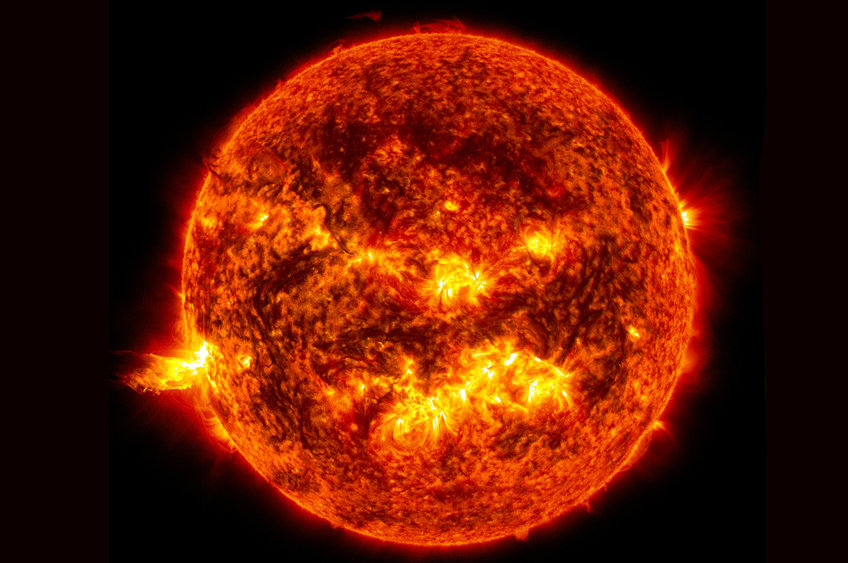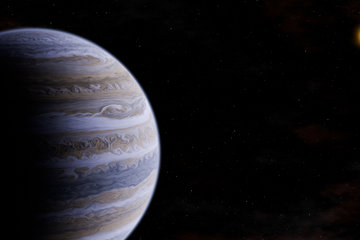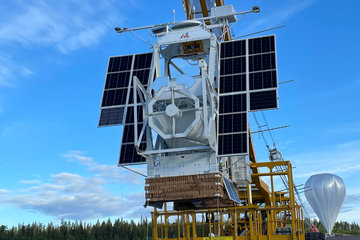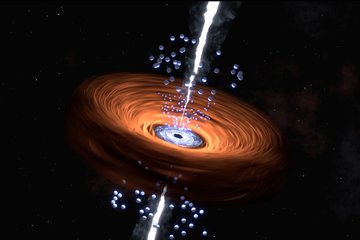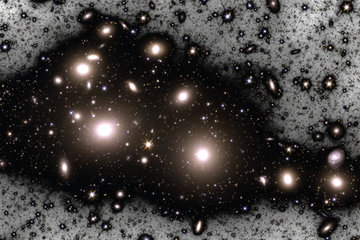Extending stellar life through a black hole
A thought experiment investigates what would happen if a tiny primordial black hole were to sit at the center of the sun
The universe could filled with small black holes - some as small as an atom and as heavy as a skyscraper. Such primordial black holes, which are said to have been created shortly after the Big Bang and that have been roaming the universe ever since, will probably not be noticable, unless you know what to look for.

In a hypothetical scenario, small, primordial black holes could be captured by newly forming stars. An international team, led by researchers at the Max Planck Institute for Astrophysics, has now modelled the evolution of these so-called “Hawking stars” and found that they can have surprisingly long lifetimes, resembling normal stars in many aspects. Asteroseismology could help to identify such stars, which in turn could test the existence of primordial black holes and their role as a component for dark matter.
What if a tiny black hole were to hit the Earth?
A journey through time, 13.8 billion years into the past, ends at the Big Bang, the beginning of everything. Extremely hot material gathered in very small space. So-called primordial black holes with very different masses and sizes could have formed in this super-dense environment. These tiny black holes may today have the mass of an asteroid, corresponding to the size of an atom, or even thousands of solar masses, which comes close to the size of the Earth. They may also form part of the invisible dark matter that dominates the mass of the universe. And they could be the nuclei of the supermassive black holes that astronomers find in the centres of today's galaxies.
Although these miniature versions of black holes should still exist today, no one has yet discovered them. Even larger variants of these matter traps can only be detected when they interact with matter, for example when matter flows towards them and emits energy in the form of light. For this to happen, however, the matter must come very close to the black hole: A microscopic black hole could, at least theoretically, have razed 2,000 square kilometres of forest in Siberia to the ground and faked an infernal asteroid impact without leaving a visible crater, explains astrophysicist Matt O'Dowd in the Radiolab podcast episode "Little Black Holes Everywhere".
When black holes get lost in stars

Meanwhile, the Max Planck Institute for Astrophysics is working on a completely different thought experiment: If we assume that many small black holes were created shortly after the Big Bang (so-called primordial black holes), it is not too likely but quite possible that a star that is currently forming could capture one due to its mass. Some of them are captured when new stars are formed. How would this affect the star as it evolves? “Scientist sometimes ask crazy questions in order to learn more,” says Selma de Mink, director of the stellar department at the Max Planck Institute for Astrophysics. “We don’t even know whether such primordial black holes exist, but we can still do an interesting thought experiment.”
The star would then have a black hole in its core. Such a star is called a “Hawking star”, named after Stephen Hawking, who first proposed this idea in a paper in the 1970s. The black hole at the centre of such a Hawking star would grow only slowly, as the infall of gas to feed the black hole is hampered by the luminosity that is directed outwards. An international team of scientists has now modelled the evolution of such a star with various initial masses for the black hole and with different accretions models for the stellar centre. Their astonishing result: when the black hole mass is small, the star is essentially indistinguishable from a normal star. “Our Sun could even have a black hole as massive as the planet Mercury at its centre without us noticing”, says says Earl Patrick Bellinger, researcher at the Max Planck Institute for Astrophysics and now Assistant Professor at Yale University.
Black hole extends life of star

Bellinger even emphasizes an advantage for the star: “Stars harboring a black hole at their centre can live surprisingly long.” A star like our sun generates its energy through nuclear fusion. When the fusion supply of hydrogen nuclei is exhausted in a few billion years, the sun will come to an end. However, if there were a black hole at its core, this would be far from the end: by then, it could have slowly but steadily gained about 0.1 percent of the sun's mass - enough mass to restart the engine through what is known as accretion of matter. In this process, matter from the interior of the sun falls onto the black hole in the centre without much resistance. This releases a large proportion of the gravitational energy very efficiently. The sun would have replaced nuclear fusion with a new source of energy and could continue to radiate for several billion years longer.
However, the influence of a black hole in the core of a Hawking star could be detectable using the relatively new field of asteroseismology, where astronomers are using acoustic oscillations to probe the interior of a star. Also in their later evolution, in the red giant phase, the black hole might lead to characteristic signatures. With upcoming projects such as PLATO, such objects might be discovered. However, further simulations are needed to determine the implications of putting a black hole into stars of various masses and metallicities.
If primordial black holes were indeed formed soon after the Big Bang, looking for Hawking stars could be one way to find them. “Even though the Sun is used an exercise, there are good reasons to think that Hawking stars would be common in globular clusters and ultra-faint dwarf galaxies,” points out Professor Matt Caplan at Illinois State University, co-author of the study. “This means that Hawking stars could be a tool for testing both the existence of primordial black holes, and their possible role as dark matter.”
BEU, HH
